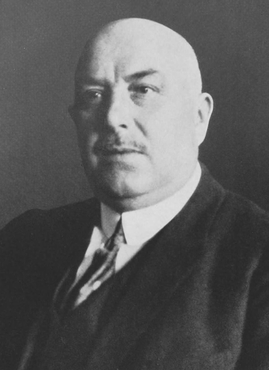Imanuel Lauster facts for kids
Quick facts for kids
Imanuel Lauster
|
|
|---|---|

Imanuel Lauster
|
|
| Head of M.A.N.'s board of directors | |
| In office 1932–1934 |
|
| Personal details | |
| Born | 28 January 1873 Münster am Neckar, Stuttgart. Württemberg, Germany |
| Died | 15 March 1948 (aged 75) Leitershofen, Stadtbergen, Bavarian Swabia, Germany |
| Education |
|
| Known for | Designing the first functional Diesel engine |
| Scientific career | |
| Fields | Mechanical engineering |
Imanuel Lauster (born January 28, 1873 – died March 15, 1948) was a German engineer and a smart businessman. He worked closely with Rudolf Diesel, who invented the Diesel engine. Lauster was the person who drew the detailed plans for the very first working Diesel engine, called the Motor 250/400. He also led the board of directors for a big company called M.A.N. from 1932 to 1934.
Contents
Early Life and Education
Imanuel Lauster was born in a small town called Münster am Neckar. This town was near Stuttgart in Germany. He grew up in a time when his family didn't have much money.
When he was 15, in 1888, he started working at a company named Gottlieb Kuhn Maschinen- und Kesselfabrik in Stuttgart. At first, they didn't need people to build machines. So, Lauster learned how to do technical drawing, which is like making detailed plans for machines. In 1889, he started working as a fitter, putting machine parts together.
Later, he helped build and test steam engines. In 1891, he moved to a new part of the company that made internal combustion engines. These engines burn fuel inside to create power. He built engines and showed them to customers.
After his training, Lauster went to college. He studied mechanical engineering at the Königliche Baugewerkschule in Stuttgart. He was a very good student and got excellent grades.
In 1894, after finishing his studies, Lauster became an assistant to Professor Georg Lindner. Professor Lindner taught at the Karlsruhe Institute of Technology (KIT). While working there, Lauster also learned about electronics and attended classes on petroleum.
Working with Rudolf Diesel
In December 1895, Lauster applied for a job at Maschinenfabrik Augsburg, which later became M.A.N. He started working there on January 2, 1896, in Rudolf Diesel's engine lab.
His first big task was to design Rudolf Diesel's third engine model, the Motor 250/400. This engine turned out to be the first Diesel engine that actually worked! Lauster finished the drawings by April 30, 1896. Some people think Diesel's assistant might have helped, but most agree Lauster did most of the design work himself.
Because of his great work, Lauster got a pay raise and a special bonus of 3000 Mark in December 1896. This was a lot of money for a young engineer.
In 1898, Lauster helped improve the first Diesel engine sold to a customer. He quickly moved up in the company. In 1899, he took over a senior role, and by 1902, he became a senior engineer. In 1904, he was put in charge of M.A.N.'s Diesel engine department.
In 1913, Lauster joined M.A.N.'s board of directors. He became the head of this board in 1932. However, in July 1934, he had to leave his position. This happened because of some business deals made by his son-in-law that caused problems for the company. From 1931 to 1933, Lauster was also a member of the board for the German Association of Engineers.
Key Inventions and Designs
Imanuel Lauster's most important work was drawing the plans for the first working Diesel engine, the Motor 250/400, based on Rudolf Diesel's ideas.
He also made other important improvements. For example, he designed a better governor for the first Diesel engine sold to customers. A governor is a device that controls the engine's speed.
Some experts also believe Lauster designed an improved fuel injector for the Diesel engine. A fuel injector sprays fuel into the engine.
In 1901, Lauster worked with Wilhelm Eberle to design the first trunk piston Diesel engine. A trunk piston is a type of piston used in engines. In 1904, they also designed the first Diesel engine for submarines, but it was never actually built.
Lauster's Relationship with Diesel
Rudolf Diesel quickly saw that Lauster was a very talented engineer. In 1896, Diesel made sure Lauster received his bonus and pay raise. In 1900, Diesel even sent Lauster another special payment.
However, Lauster and Diesel never became close friends. Later, Diesel had some disagreements with Lauster. One reason might have been Diesel's feeling that Lauster wasn't fully supporting the Diesel engine's success. Because of this, Diesel sometimes wrote that Lauster's help was only a small part of the engine's development.

